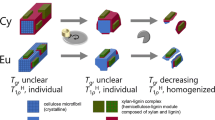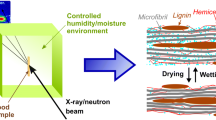Summary
By measuring the proton spin–lattice relaxation times (T1H) in the solid-state for black spruce softwood, the molecular mobilities of carbohydrates and lignin have been evaluated as a function of pH. These studies have shown that the mobility of the polymeric constituents of wood is affected by the ionization of the different functional groups at different pH's. The analyses of the proton-spin–lattice relaxation time data at constant humidity revealed that the maximum T1H for both carbohydrates and lignin occurs at about neutrality, while it was found to be depressed at the two extremes of the pH range. By treating a wood sample with propylene oxide, the esterification of the acid groups was affected, thus deactivating the ionization process and their contribution to T1H. The experimental T1H values for cellulose and lignin after the esterification were significantly decreased at pH 6 confirming that their ionization plays a very significant role in determining chain mobility.
Similar content being viewed by others
Author information
Authors and Affiliations
Additional information
Received 1 December 1998
Rights and permissions
About this article
Cite this article
Ahvazi, B., Argyropoulos, D. Proton spin–lattice relaxation time measurements of solid wood and its constituents as a function of pH: Part I* . Wood Science and Technology 34, 45–53 (2000). https://doi.org/10.1007/s002260050007
Issue Date:
DOI: https://doi.org/10.1007/s002260050007




